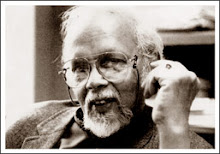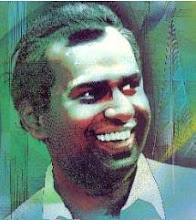Author: Jayanthi Liyanage
Source:Daily News
Date: 02/09/2009
Title: Ediriweera Sarachchandra’s Sinhabahu; English Version and a Pre-Production Image.
Author: Namel Weeramuni
Sarasavi Publishers
“On the face of this earth exists a state called love,
which exquisitely, divinely,
the poets of fame of antiquity
aesthetically and artistically,
sang most richly, in verse and lyric form.
All luxury, all wealth, all power and honour
Mankind leaves for
this exquisite state of love which brings
celestial pleasure of unreachable horizons
like Sithumina, the heavenly Magical Gem
that fulfills all desires of Mankind.”
The above verse, the Sinhala version of which you may be familiar with, comes from the English version of the late Prof. Ediriweers Sarachchandra’s famous stage play Sinhabuhu, translated by Namel Weeramuni. The book Sinhabahu, English Version and a Pre-Production Image, was first published in 1999.
Namel sought his guru Prof. Sarachchandra’s permission to do the translation while the Professor was warded at the Colombo General Hospital, seriously ill. 
“He hugged me, taking my head to his chest,” records Namel. “Tears ran down his cheeks. I did not realize he was telling me that would be the last time alive he would see me. I did not want him to die that soon. He died on August 16, 1996.” The English version was produced and presented in Los Angeles, United States, for the first time in February 1997.
The late Prof. Anuradha Seneviratne, providing a foreword to the book, says that Namel, as a student of Prof. Sarachchandra during his days at Peradeniya, was keen to follow in the footsteps of the revered teacher and became a playwright and a producer himself.
“It is indeed no easy task for any person however much he is qualified, to undertake a job of this nature, to absorb and transform the richness of the original play. It was the perceptiveness of Namel with his knowledge of grammar of the drama, and the nuances of the language that he was able to successfully complete the task.”
Lalitha Sarachchandra, in her preface to the book says that if it had not been for Namel and Malini Weeramuni, the Sarachchandra Drama Troupe would never have had the opportunity to perform Maname at the prestigious Mermaid Theatre at the West End in London.
“The standing ovations Prof. Sarachchandra received from the audience at the end of the performances were undoubtedly the most memorable instances of his life. I wondered then whether there could possibly be any greater gift or honour a student could bestow upon his guru.”
Namel states that many narratives have evolved about Queen Suppadevi and her co-habitation with a lion, differing in depth and authenticity.
One is the poem Siyabas Maldama by the Buddhist monk Ven. Kirama Dhammananda. Sinhavalli Naadagama by Phillppu Singho was the adaptation of this poem to a play. Sinhabahu is a tragedy, composed in the style of Nadagama.
Namel records that music is the ‘spine’ of the play. Through music, the theme of the play is enhanced. He says that through music, situations sharpen and the playwright penetrates into interactions and psycho-actions of human behaviour, passing deeply into the roots of humanity.
“In power and in splendour like the sun
holding up the sky, as a golden pillar by its radiance,
Raising his sinew arms, Sinhabahu strained his might
and propelled away the rock that held them captive in the den.”
In the pre-production image of Sinhabahu, Namel analyses the story and his verses in a manner that breathes life into inanimate words and his characterisations carve deep etchings in the reader’s mind. English he has used is delicate and sensuous and draws out the bondage of love woven among the players and the devastation that follows once this bondage is torn asunder.
Sinhabahu was translated into English for the first time by Lakshmi de Silva of the Department of English, Kelaniya University. This play was published in New Ceylon Writing, Sydney, Australia in 1984 and presented as a public reading production by Earnest MacIntrye at the British Council in honour of Prof. Sarachchandra’s 75th birthday in 1989.
In concluding the pre-production image, Namel describes the text of Sinhabahu as one that delves deeply into a character of ambition, social mores, honour and dignity.
If you have read Sinhabahu in Sinhala, read it again in English and you will rediscover the characters of the Lion King, Suppadevi, Sinhabahu and Sinhasivali with pathos you never thought was possible.




































No comments:
Post a Comment